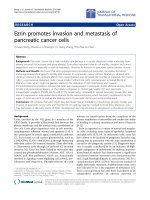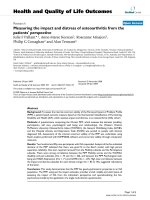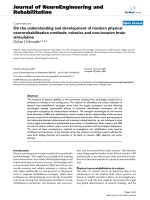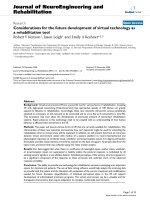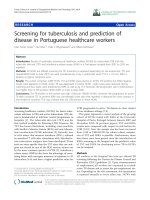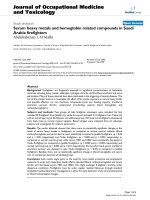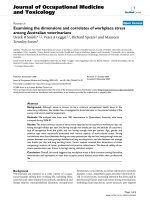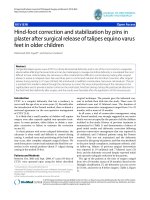báo cáo hóa học: " Screening for tuberculosis and prediction of disease in Portuguese healthcare workers" docx
Bạn đang xem bản rút gọn của tài liệu. Xem và tải ngay bản đầy đủ của tài liệu tại đây (277.85 KB, 6 trang )
RESEARCH Open Access
Screening for tuberculosis and prediction of
disease in Portuguese healthcare workers
José Torres Costa
1,2
, Rui Silva
1,2
, Felix C Ringshausen
3
and Albert Nienhaus
3*
Abstract
Introduction: Results of systematic screening of healthcare workers (HCWs) for tuberculosis (TB) with the
tuberculin skin test (TS T) and interferon-g release assays (IGRA) in a Portuguese hos pital from 2007 to 2010 are
reported.
Methods: All HCWs are offered screening for TB. Screening is repeated depending on risk assessment. TST and
QuantiFERON Gold In-Tube (QFT) are used simultaneously. X-ray is performed when TST is > 10 mm, IGRA is
positive or typical symptoms exist.
Results: The cohort comprises 2,889 HCWs. TST and IGRA were positive in 29.5%, TST-positive but IGRA-negative
results were apparent in 43.4%. Active TB was diagnosed in twelve HCWs - eight cases were detected during
screening and four cases were predicted by IGRA as well as by TST. However, the progression rate in IGRA-positive
was higher than in TST-positive HCWs (0.4% vs. 0.2%, p-value 0.06 ).
Conclusions: The TB burden in this cohort was high (129.8 per 100,000 HCWs). However, the progression to active
TB after a positive TST or positive IGRA was considerably lower than that reported in literature for close contacts in
low-incidence countries. This may indicate that old LTBI prevails in these HCWs.
Introduction
Screening healthcare workers (HCWs) for latent tuber-
culosis infection (LTBI) and active tuberculosis (TB) dis-
ease is fundamental in infection control programmes in
hospitals [1]. The tuberculin skin test (TST) was the
first method available for detecting LTBI. How ever, the
TST has known lim itations, including cross-reactivity
with bacillus Calmette-Guérin ( BCG) and non-tubercu-
lous mycobacteria (NTM) infections [2]. Recently, new
in vitro assays that measure interferon (IFN)-g released
by sensitised T cells after stimulation with Mycobacter-
ium tuberculosis antigens have been developed. These
tests are more specific than the TST since they use anti-
gens not shared by any of the BCG vaccine strains nor
by the more c ommon species of NTM [3]. Interferon-g
release assays (IGRAs) also have the advantage of corre-
lating better with surrogate measures of expo sure to M.
tuberculosis [4-6] and have a higher predictive value for
LTBI progression to active TB disease in close contact
in low-incidence settings [7,8].
This paper represents a recent analysis of the growing
cohort of HCWs tested with IGRA at the University
Hospital of Porto, Portugal, between January 2007 and
December 2010. In previous papers, TST and IGRA
results were compared with respect to risk factors for
LTBI [9,10]. Now the sample size has been increased
from 1,218 to 2,884 HCWs for whom a di rect compari-
son of TST and IGRA is possible. Furt hermore, more
than three years have passed since the introduction of
IGRA screening at the hospital and the predictive value
of TST and IGRA for developing active TB in HCWs
can be analysed.
Methods
All workers at the Hospital São João are offered TB
screening following the Centers for Disease Control and
Prevention (CDC) guidelines [ 1]. Upon commencement
of employment, all workers are examined to exclude
active TB disease and to assess the pre-employme nt sta-
tus. Depending on the risk assessment, the examination
is repeated annually or every other year. HCWs with
* Correspondence:
3
University Medical Centre Hamburg-Eppendorf, Institute for Health Services
Research in Dermatology and Nursing, Hamburg, Germany
Full list of author information is available at the end of the article
Torres Costa et al. Journal of Occupational Medicine and Toxicology 2011, 6:19
/>© 2011 Costa et al; licensee BioMed Central Ltd. This is an Open Access article dis tribu ted under the terms of the Creative Commons
Attribution License ( censes/by/2.0), which permits unrestricted use, distribution, and reprod uction in
any medium, provided the original work is properl y cited.
close patient contacts in the infecti on and TB wards are
considered to be at a high risk, workers with regular
patient contacts in t he other wards are considered to be
at a me dium risk and workers with no regular patient
contacts and no contact with biological material are
considered to be at a low risk. After unprotected contact
with an infectious patient, co-worke r or material,
screening is performed as well.
Since January 2007, screening has been performed
using TST and IGRA. A chest X-ray is performed in
order to exclude active pulmonary disease w hen TST is
considered positive (≥ 10 mm), when IGRA is positive
and in HCWs with symptoms. BCG vaccination is
assessed through the individual vaccination register. If
no register is available, vaccination status is verified by
scars. BCG vaccination for newborns is mandatory in
Portugal and, until January 2000, was repeated depend-
ing on risk assessment and TST diameter. Therefore
every HCW is considered to have been vaccinated at
least once.
TST is performed by trained personnel following stan-
dard procedures. In brief, 0.1 mL (2 TU) of purified pro-
tein derivative (PPD, RT23; Statens Serum Institute,
Copenhagen, Denmark) is injected. The TST is adminis-
tered to the volar side of the forearm of the participants
and read 72 to 96 hours after the application. The trans-
verse diameter of the induration is measured by experi-
enced personnel.
Before the TS T application, an interview is per formed
and blood for the IGRA is drawn. For the IGRA, the
QuantiFERON-TB
®
Gold In-Tub e Assay (Cellestis Lim-
ited, Carnegie, Australia) is used. This whole-blood
assay uses overlapping peptides corresponding to ESAT-
6, CFP-10 and a portion of the tuberculosis antigen
TB7.7 (Rv2654). Stimulation of the a ntigenic mixture
occurs within the tube used to collect blood. Tubes
were incubated at 37 C overnight before centrifugation,
and INF-g release is measured by ELISA following the
protocol of the manufactu rer. All assays performed met
the manufacturer’s quality control standards. The test is
considered positive when INF-g is ≥ 0.35 IU af ter cor-
rection for the negative control. Observers were blinded
to the results of the TST results.
A chi-square test was used to compare the frequencies
of test results among different groups of part icipants.
For risk factors assessed by ordinal variables, the p ro-
portions of positive test results were compared using
thechi-squaretestoftrend.Abinomialtestwasused
for the comparison of active TB rates and TB predicted
rates of TST and IGRA. P < 0.05 was considered to be
statistically significant. A djusted odds ratios (OR) and
95% confidence intervals (CI) were calculated for differ-
ent putative predi ctive variabl es using conditional logis-
tic regression.
Data analysis was performed with SPSS, Version 14
(SPSS Inc., Chicago, Illinois). All persons gave their
informed consent prior to their inclusion in the study.
No additional data was collected for the study purpose
only and analysis was performed with anonymous data.
Therefore no endorsement by an ethics committee was
required.
Results
The flow chart of the study sample is given in Figure 1.
Undetermined results of the IGRA were observed in 5
HCWs (5/2,889). A total of 850 HCWs (29.5%) was
positive in TST and IGRA. Twelve of these HCWs
(1.5%) were diagnosed with active TB. Four HCWs were
diagnosed with TB more than three months after the
positive TST and IGRA. The characteristics of the study
population are given in Table 1. The cohort is predomi-
nantly female (71.7%) and the majority were repeatedly
vaccinated with BCG (68.2%). Infection risk was consid-
ered moderate for 59.7% of the cohort. The mean fol-
low-up time for the HCWs was 19 months, SD 5.2
month (no table).
IGRAwaspositivein33%andTSTwas10mmor
higher in 72.9% of the HCWs (Table 2). The probability
of a positive IGRA increased with diameter in TST.
However, 42.4% of the HCWs with a TST o f ≥ 20 mm
were negative in IGRA and 11.2% with a TST of < 5
mm were positive in IGRA.
Age is a risk factor for a positive TST (≥ 10 mm) as
well as a positive IGRA (Table 3). However, the adjusted
ORfortheIGRAshowamorepronounceddose-
response relationship with age than the TST, e.g. OR in
HCWs aged 50 or older for positive TST 2.0 and for
positive IGRA 2.7 (Table 3). Gender was not associated
with TST or IGRA. Repeated BCG vaccination did not
IGRA and TST
2,889
Undetermined IGRA
5 (< 1%)
Comparison of IGRA and TST
2,884
IGRA+/TST+
850 (29.5%)
IGRA-/TST+
1,252 (43.4%)
IGRA+/TST-
103 (3.6%)
IGRA-/TST-
679 (23.5%)
Active TB
12 (1.4%)
Active TB
0
Active TB
0
Active TB
0
When tested
8 (0.9%)
Predicted
4 (0.5%)
Figure 1 Flow chart of study population.
Torres Costa et al. Journal of Occupational Medicine and Toxicology 2011, 6:19
/>Page 2 of 6
influence TST, but was associa ted with a decreased
probability of positive IGRA, e.g. OR = 0.4 (95% CI 0.3-
0.6) for three or more additional vaccinations. Profes-
sion an d risk assessment were not associated with TST
or IGRA results. The number of y ears working in
healthcare increased the probabili ty of positive TST and
Table 1 Study population for comparison of IGRA with
TST
Age N %
< 25 years 301 10.4
25-29 years 821 28.5
30-39 years 791 27.4
40-49 years 534 18.5
≥ 50 years 437 15.2
Gender
Female 2,068 71.7
Male 816 28.3
BCG vaccination
Only at birth 917 31.8
One additional 1,022 35.4
Two additional 663 23.0
≥ 3 additional 282 9.8
Profession
Administrator 388 13.5
Auxiliaries, cleaning staff 487 16.9
Technicians (radiology, lab, etc.) 170 5.9
Nurses 1,204 41.7
Physicians 635 22.0
Risk assessment
Low risk 206 7.1
Moderate risk 1,722 59.7
High risk 956 33.1
Years working in healthcare
Start of work 400 13.9
< 1 years 141 4.9
1-5 years 787 27.3
>5-10 years 465 16.1
10-20 years 573 19.9
≥ 20 years 518 18.0
Table 2 TST diameter by IGRA results
IGRA
TST Negative Positive Total
N Row% N Row% N Col%
0-4 mm 596 88.8 75 11.2 671 23.3
5-9 mm 83 74.8 28 25.2 111 3.8
10-14 mm 623 73.3 227 26.7 850 29.5
15-19 mm 468 53.7 404 46.3 872 30.2
≥ 20 mm 161 42.4 219 57.6 380 13.2
All 1,931 67.0 953 33.0 2,884 100.0
TST = Tuberculin skin test
IGRA = Interferon-g release assay
Row% = % within the TST category
Col% - Column% = % of total falling into a certain TST category
P-value for linear trend < 0.001
Table 3 Adjusted odds ratios (OR) and 95% confidence
intervals (CI) for tuberculin skin tests (TST) of ≥ 10 mm
and positive interferon-g release assays (IGRA)
TST ≥ 10 mm IGRA-positive
Age N (%) OR 95%CI N (%) OR 95%CI
< 25 years 223 (74.1) 1 – 57 (18.9) 1 –
25-29 years 532 (64.8) 0.6 0.5-0.8 204 (24.8) 1.3 0.93-1.8
30-39 years 553 (69.9) 0.8 0.6-1.1 266 (33.6) 1.9 1.4-2.6
40-49 years 424 (79.4) 1.5 1.0-2.1 219 (41.0) 2.3 1.6-3.3
≥ 50 years 370 (84.7) 2.0 1.4-3.0 207 (47.4) 2.7 1.9-3.9
Gender
Female 1,487
(71.9)
1 – 658 (31.8) 1 –
Male 615 (75.4) 1.2 0.97-
1.4
295 (36.2) 1.1 0.9-1.3
BCG vaccination
Only at birth 700 (76.3) 1 – 406 (44.3) 1 –
One additional 741 (72.5) 1.0 0.8-1.2 330 (32.3) 0.7 0.6-0.9
Two additional 460 (69.4) 1.0 0.7-1.2 165 (24.9) 0.6 0.5-0.7
3-10 additional 201 (71.3) 1.0 0.8-1.4 52 (18.4) 0.4 0.3-0.6
Profession
Administrator 302 (77.8) 1 156 (40.2) 1 –
Auxiliaries, cleaning
staff
335 (68.8) 0.8 0.6-1.1 180 (37.0) 1.0 0.7-1.3
Technicians (radiology,
lab, etc.)
137 (80.6) 1.6 1.0-2.5 54 (31.8) 1.0 0.7-1.5
Nurses 864 (71.8) 1.3 0.95-
1.8
317 (26.3) 0.8 0.6-1.1
Physicians 464 (73.1) 1.2 0.9-1.7 246 (38.7) 1.4 1.04-1.9
Risk assessment
Low risk 176 (85.4) 1 – 85 (41.3) 1 –
Moderate risk 1,289
(74.9)
0.6 0.4-
0.91
549 (31.9) 0.8 0.6-1.2
High risk 637 (66.6) 0.4 0.3-0.6 319 (33.4) 0.9 0.7-1.3
Years working in
healthcare*
Start of work 289 (72.3) 1 – 112 (28.0) 1 –
< 1 years 84 (59.6) 0.6 0.4-
0.92
26 (18.4) 0.7 0.4-1.1
1-5 years 502 (63.8) 0.7 0.5-
0.91
211 (26.8) 1.1 0.8-1.4
> 5-10 years 324 (69.7) 0.9 0.7-1.2 154 (33.1) 1.4 1.06-2.0
10-20 years 454 (79.2) 1.5 1.1-2.1 212 (37.0) 1.6 1.2-2.2
≥ 20 years 449 (86.7) 2.5 1.8-3.6 238 (45.9) 1.9 1.4-2.5
* Correlatio n between age and years working in healthcare r = 0.82. Separate
models were calculated for these variables
Torres Costa et al. Journal of Occupational Medicine and Toxicology 2011, 6:19
/>Page 3 of 6
IGRA. The highest OR (2.5) was observed for TST when
working for 20 or more years in healthcare. However,
due to high correlation between the variables of age and
years working in healthcare, it is not possible to separate
both effects.
Discordant TST+/IGRA- combinations are most likely
(57.8%) in HCWs younger than 25 years and less likely
in HCWs older than 50 years (40%). Gender is not asso-
ciated with discordant TST and IGRA results (Table 4).
The probability of TST+/IGRA- discordance increased
from 35.8% in those with BCG vaccination at birth only
to 55 .7% in those with three or more repeated vaccina-
tions. Technicians (52.4%) and nurses (48.6%) had the
highest rates of TST+/IGRA- discordant results.
Fifty-seven HCWs (2.0%) had a history of active TB dis-
ease since 2005 an d were treated accordingly. Of these,
86% had a TST of ≥ 10 mm and 59.6% a positive IGRA
when screened in the scope of this study (Table 5). Eight
HCWs had active TB at the time of screening, and pro-
gression to active TB with in 4 to 24 months of screeni ng
occurred in four HCWs. S ensitivity for prevalent and for
predicted active TB was 100% for both TST of ≥ 10 mm
and IGRA. The rate of prevalent and predicted active TB
in IGRA-positive HCWs (0.8% a nd 0.4%) was twice as
high as the rates for HCWs with TST of ≥ 10 mm (0.4%
and 0.2%). However, the diff erence was only s tatistically
significant (p = 0.008) for prevalent active TB. The p-value
for the different progression rates was 0.06 (Table 5).
Table 4 Concordant and discordant tuberculin skin test (TST) of ≥ 10 mm and interferon-g release assay (IGRA) results
depending on putative risk factors
TST/IGRA
Neg./Neg. Pos./Neg. Neg./Pos. Pos./Pos. P
Age N % n % n % n % <0.001
< 25 years 70 23.3 174 57.8 8 2.7 49 16.3
25-29 years 258 31.4 359 43.7 31 3.8 173 21.1
30-39 years 203 25.7 322 40.7 35 4.4 231 29.2
40-49 years 93 17.4 222 41.6 17 3.2 202 37.8
≥ 50 years 55 12.6 175 40.0 12 2.7 195 44.6
Gender
Female 508 24.6 902 43.6 73 3.5 585 28.3
Male 171 21.0 350 42.9 30 3.7 265 32.5 0.078
BCG vacci.
At birth 183 20.0 328 35.8 34 3.7 372 40.6
Plus one additional 245 24.0 447 43.7 36 3.5 294 28.8
Plus two 178 26.8 320 48.3 25 3.8 140 21.1
Plus 3-10 73 25.9 157 55.7 8 2.8 44 15.6 <0.001
Profession
Administrator 72 18.6 160 41.2 14 3.6 142 36.6
Auxiliaries, cleaning 133 27.3 174 35.7 19 3.9 161 33.1
Technicians (radiology, lab, etc.) 27 15.9 89 52.4 6 3.5 48 28.2
Nurses 302 25.1 585 48.6 38 3.2 279 23.2
Physicians 145 22.8 244 38.4 26 4.1 220 34.6 <0.001
Risk
Low 27 13.1 94 45.6 3 1.5 82 39.8
Moderate 378 22.0 795 46.2 55 3.2 494 28.7
High 274 28.7 363 38.0 45 4.7 274 28.7 <0.001
Years in healthcare
Start of work 96 24.0 192 48.0 15 3.8 97 24.3
< 1 years 51 36.2 64 45.4 6 4.3 20 14.2
1-5 years 248 31.5 328 41.7 37 4.7 174 22.1
> 5-10 years 124 26.7 187 40.2 17 3.7 137 29.5
10-20 years 103 18.0 258 45.0 16 2.8 196 34.2
≥ 20 years 57 11.0 223 43.1 12 2.3 226 43.6 <0.001
Torres Costa et al. Journal of Occupational Medicine and Toxicology 2011, 6:19
/>Page 4 of 6
Discussion
This is the first study to report sensitivity for disease
progression in HCWs simultaneously tested with IGRA
and TST. However, even t hough the study sample was
huge (n = 2,884), calculation of the disease progression
rate is based on four cases only. In IGRA-positive
HCWs, it was twice as high as in HCWs with TST of ≥
10 mm. However, the difference was not statistically sig-
nificant. The progression rate we observed was consider-
ably lower than the one observed in close contacts in a
German cohort [7,8]. Apart from a shorter follow-up
period in our st udy, this indicates that old infections,
which have a lower progression risk, prevail in the
HCW cohort. As with TST, IGRAs are not able to dis-
tinguish old from recent LTBI [11]. In HCWs with a
positive IGRA, the likelihood of a recent LTBI can only
be assessed by evaluation of the exposure situation
within the last m onths before the IGRA is performed.
This should be done from case to case, as the exposure
assessment following CDC [1] was not helpful in this
endeavour.
Even though the sample size increased from 1,219 to
2,884 compared to our first publication [9], the rates for
positive IGRA and TST of ≥ 10mmareverysimilar
(32.6% versus 33.1% for IGRA and 74.2% versus 72.9%
for TST of ≥ 10 mm). The rate of positive IGRA is con-
siderablyhigherinPortugueseHCWsthaninHCWs
from other West-European countries, reflecting the
higher TB-incid ence in Portugal than in other West-
European countries [12-14]. The twelve cases of active
TB observed in our population gives rise to a TB inci-
dence rate of 129.8 per 100,000 HCWs. The rate is con-
siderably lower than the rate of 191.6 per 100,000
HCWs observed in our previous publicat ion [9]. But the
rate is still about four times higher than the annual inci-
dence rate in the general population in Portugal in 2006
of 32/100,000 [9]. This comparison illustrates the bene-
ficial aspects of s ystematic screening of HCWs in a
medium-incidence country and the increased risk of TB
infection in HCWs.
In Portugal, BCG vaccination is universal and, until
January 2000, was repea ted when a person was negative
in the TST. This makes it difficult to examine the influ-
ence of BCG vaccination on TST or IGRA. Little is cur-
rently known about the effect of repeated BCG
vaccination on the probability of TST+/IGRA- discor-
dant results [11,15]. As was expected, repeated BCG
vaccination increased the probability of TST results
higher than 10 mm. However, a recent BCG vaccination
or a repeated BCG vaccination decreased the probability
ofapositiveIGRA.Thismightindicateaprotective
effect of BCG vaccination or may have been caused by
the revaccination schema: TST-negative HCWs are
revac cinated, inducing a positive TST, without changing
the IGRA. Increasing the cut-off for a positive TST
from 10 to 15 mm reduced the number of positive
TSTs (72.9 vs. 43.4), but also increased the probability
of a positive IGRA not detected by TST (10.8% vs.
34.6%, calculated from Table 2). Theref ore, this strategy
is not suitable to r educ e the spec if icit y problems of the
TST in a population which is BCG-vaccinated.
Nurses had a higher rate of TST+/QFT- results than
physicians (48.6 vs. 38.6%, Table 4) but were also tested
more often than physicians with TST [9]. This indicate s
that risk assessment may be biased by using TST. The
reason why nurses underwent TST more often tha n
doctors is unknown; but one reasonable assumption is
that they were more compliant in earlier contact
tracings.
Working in healthcare is a well-known risk factor for
TB [16,17]. In our data, the probability of a positive
IGRA (Table 3) or of TST+/IGRA+ concord ance (Table
4) increased with the number of years spent in health-
care. However, this association might be explaine d by
age alone. Surprisingly, neither risk assessment [1] nor
profession was associated with TST or with IGRA, or
the association observed was in an unexpected direction.
In the two European fingerprint studies [18,19], the
majority of work- related active TB cases occurred when
the infe ction risk was considere d to be low and preven-
tive measures were not in place because TB was not
suspected. Rotation of the staff is a further potential
explanation for the lack of this associatio n. Therefore
risk assessment should be reconsidered.
Screening HCWs for LTBI with TST in our popula-
tions had severe shortcomings. The rate of TST of > 10
mm was high and was influenced by repeated BCG vac-
cination, allowing littl e discrimination between HCWs
Table 5 Old, active, and predicted TB by TST and IGRA
results
TST IGRA Total
0-9 mm ≥ 10 mm Neg. Pos.
TB history n % n % n % N % n %*
Old TB 8 14.0 49 86.0 23 40.4 34 59.6 57 2.0
Prevalent
active TB
0 – 8 0.4* 0 – 8 0.8* 8 0.3
Predicted
TB**
0 – 4 0.2* 0 – 4 0.4* 4 0.1
No TB 774 27.5 2102 72.9 1908 67.8 953 32.8 2815 97.6
* Column%
** Time between test and diagnosis of active TB > 3 months
Progression rate:
TST ≥ 10 mm = 0.2%
IGRA positive = 0.4%, p = 0.06
Active TB rate:
TST ≥ 10 mm = 0.4%
IGRA positive = 0.8%, p = 0.008
Torres Costa et al. Journal of Occupational Medicine and Toxicology 2011, 6:19
/>Page 5 of 6
at risk of having or of progressing to active TB. On the
contrary, t he IGRA was not influenced by BCG vaccina-
tion. Therefore our data corroborates the conclusion of
other HCW studies [20,21] that the TST is not useful in
contact investigations among BCG-vaccinated HCWs,
while IGRA may provide additional information for the
diagnosis and strategic manag ement of preventive treat-
ment in BCG-vaccinated HCW.
All eight HCWs diagnosed with active TB were posi-
tive in both tests. In summary, the IGRA was therefore
better than the TST in screening H CWs for LTBI and
active TB. Overall, screening of HCWs was successful
because of the high number of active TB cases identified
through this systematic screening. Future studies should
investigate the incidence of new TB infections and the
beneficial effect of chemoprevention in these HCWs.
Author details
1
Hospital São João, EPE Alameda Professor Hernâni Monteiro, Porto, Portugal.
2
Faculty of Medicine, Porto University Alameda Professor Hernâni Monteiro,
Porto, Portugal.
3
University Medical Centre Hamburg-Eppendorf, Institute for
Health Services Research in Dermatology and Nursing, Hamburg, Germany.
Authors’ contributions
JTC designed the study, performed the physical examinations, and was
involved in drafting of the paper. RS was involved in data collection and
drafting of the paper. FR was involved in data analysis and drafting of the
paper. AN analysed the data and wrote the first draft of the paper. All
authors read and approved the final manuscript.
Competing interests
The authors declare that they do not have any direct or indirect personal
relationship, affiliation or association with any party with whom they deal in
their day-to-day work that would give rise to any actual or perceived
conflict of interest.
Received: 15 March 2011 Accepted: 9 June 2011 Published: 9 June 2011
References
1. Jensen PA, Lambert LA, Iademarco MF, Ridzon R: Guidelines for preventing
the transmission of Mycobacterium tuberculosis in Healthcare Settings.
MMWR 2005, 54(RR-17):1-141.
2. Menzies D: What does tuberculin reactivity after Bacille Calmette-Guerin
vaccination tell us? Clin Infect Dis 2000, 31(Suppl. 3):S71-S74.
3. Andersen P, Munk ME, Pollock JM, Doherty TM: Specific immune-based
diagnosis of tuberculosis. Lancet 2000, 356:1099-1104.
4. Nahid P, Pai M, Hopewell PC: Advances in the diagnosis and treatment of
tuberculosis. Proc Am Thorac Soc 2006, 3:103-110.
5. Diel R, Loddenkemper R, Meywald-Walter K, Gottschalk R, Nienhaus A:
Comparative Performance of Tuberculin Skin Test, QuantiFERON-TB-Gold
In Tube Assay, and T-Spot.TB Test in Contact Investigations for
Tuberculosis. Chest 2009, 135(4):1010-1018.
6. Diel R, Loddenkemper R, Nienhaus A: Evidence based comparison of
commercial interferon-gamma release assays for detecting active
tuberculosis – a meta-analysis. Chest 2010, 137(4):952-968.
7. Diel R, Loddenkemper R, Meywald-Walter K, Niemann S, Nienhaus A:
Predictive value of a whole blood IFN-c assay for the development of
active TB disease. Am J Respir Crit Care Med 2008, 177:1164-1170.
8. Diel R, Loddenkemper R, Niemann S, Meywald-Walter K, Nienhaus A:
Negative and positive predictive value of a whole-blood Interferon-γ
Release Assay for developing active tuberculosis - An Update. Am J
Respir Crit Care Med 2011, 183:88-95.
9. Torres Costa J, Sá R, Cardoso MJ, Silva R, Ferreira J, Ribeiro C, Miranda M,
Plácido JL, Nienhaus A: Tuberculosis screening in Portuguese healthcare
workers using the tuberculin skin test and the interferon-gamma release
assay. Eur Respir J 2009, 34:1423-8.
10. Torres Costa J, Silva R, Cardoso MJ, Nienhaus A: Results of five-year
systematic screening for latent tuberculosis infection in healthcare
workers in Portugal. J Occup Med Toxicol 2010, 5:22.
11. Nienhaus A, Schablon A, Diel R: Interferon-γ release assay for the
diagnosis of latent TB infection - analysis of discordant results, when
compared to the tuberculin skin test. PLoS ONE 2008, 3(7):e2665.
12. Schablon A, Beckmann G, Harling M, Diel R, Nienhaus A: Prevalence of
latent tuberculosis infection among healthcare workers in a hospital for
pulmonary diseases. J Occup Med Toxicol 2009, 4:1.
13. Schablon A, Harling M, Diel R, Nienhaus A: Risk of latent TB infection in
individuals employed in the healthcare sector in Germany: a multicentre
prevalence study. BMC Infect Dis 2010, 10 :107.
14. Tripodi D, Brunet-Court , Nael V, Audrain M, Chailleux E, Germaud P,
Naudin F, Muller JY, Bourrut-Lacouture M, Durand-Perdriel MH, Gordeeff C,
Guillaumin G, Houdebine M, Raffi F, Boutoille D, Biron C, Potel G,
Roedlich C, Geraut C, Schablon A, Nienhaus A: Evaluation of the tuberculin
skin test and the interferon-gamma release assay for TB screening in
French healthcare workers. J Occup Med Toxicol 2009, 4:30.
15. Farhat M, Greenaway , Pai M, Menzies D: False-positive tuberculin skin
tests: what is the absolute effect of BCG and non-tuberculous
mycobacteria? Int J Tuberc Lung Dis 2006, 10(11):1192-1204.
16. Menzies D, Joshi R, Pai M: Risk of tuberculosis infection and disease
associated with work in health care settings. Int J Tuberc Lung Dis 2007,
11(6):593-605.
17. Seidler A, Nienhaus A, Diel R: Review of epidemiological studies on the
occupational risk of tuberculosis in low-incidence areas. Respiration 2005,
72(4):431-446.
18. Diel R, Seidler A, Nienhaus A, Rusch-Gerdes S, Niemann S: Occupational
risk of tuberculosis transmission in a low incidence area. Respir Res 2005,
6(1):35-45.
19. De Vries G, Sebek MM, Lambregts-van Weezenbeek CS: Healthcare workers
with tuberculosis infected during work. Eur Respir J 2006, 28(6):1216-21.
20. Nienhaus A, Schablon A, Siano B, le Bacle C, Diel R: Evaluation of the
interferon-gamma release assay in healthcare workers. Int Arch Occup
Environ Health 2008, 81:295-300.
21. Ringshausen FC, Schlosser S, Nienhaus A, Schablon A, Schultze-
Werninghaus G, Rohde G: In-hospital contact investigation among health
care workers after exposure to smear-negative tuberculosis. J Occup Med
Toxicol 2009, 4(1):11.
doi:10.1186/1745-6673-6-19
Cite this article as: Torres Costa et al.: Screening for tuberculosis and
prediction of disease in Portuguese healthcare workers. Journal of
Occupational Medicine and Toxicology 2011 6:19.
Submit your next manuscript to BioMed Central
and take full advantage of:
• Convenient online submission
• Thorough peer review
• No space constraints or color figure charges
• Immediate publication on acceptance
• Inclusion in PubMed, CAS, Scopus and Google Scholar
• Research which is freely available for redistribution
Submit your manuscript at
www.biomedcentral.com/submit
Torres Costa et al. Journal of Occupational Medicine and Toxicology 2011, 6:19
/>Page 6 of 6
